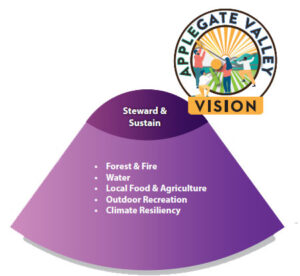Although the Applegate Valley was the original homeland of the Shasta and the Dakubetede, little remains of their presence. Their temporary dwellings of light pole frames are long gone, as are the semi-permanent plank lodges of their winter villages.
A trained eye might be able to see evidence of indigenous cultural fire practices and land-tending throughout the Applegate drainage. But for the most part, all evidence of the tribes was erased after the white settlers arrived and initiated the Rogue River Wars in the 1850-1856. Some of their descendants do live on today at the Siletz and Grande Ronde reservations.
Applegate valley resident, Janis Mohr-Tipton, feels it’s important to create a physical space that invokes the memory of the Valley’s original inhabitants. To honor the “People of the Beautiful Valley” and other tribes that were indigenous to the region, she applied for an Innovation Grant to go toward an ongoing project to build a monument in Cantrall Buckley Park.
This project falls under the Inclusive & Engaged portion of the Applegate Valley Vision, an 89-page resident-guided document that outlines strategies for improving the quality of life in the Applegate Valley.
“It was nice to finally have land acknowledgements to recognize the First People who had been here, but it’s not enough.” When “The Dragonfly Place” is completed, it will consist of an engraved stone, a gathering area, native plants, and an interpretive sign. The stone will pay tribute to elder Taowhywee, Agnes Baker Pilgrim.
“Grandmother Agnes” was an elder and member of the Takelma Rogue River Tribe and the Confederated Tribes of Siletz, and founding member of the International Council of Thirteen Indigenous Grandmothers. She was a “voice for the voiceless” and strong advocate for clean water and Native American Rights.
Janis has a long connection to the park, helping keep it afloat during the years after it lost country funding (1997) and before eventually becoming the Chair of the Park Enhancement Committee in 2018. To date, she has overseen a pollinator garden, stream restoration efforts, a milkweed project, and a sculpture garden. She’s also coordinated community volunteer events. The monument is her latest effort. She is working with a Cultural Committee that formed from the Applegate Partnership & Watershed Council.
“I had a conversation about the monument with Steve Lambert, the park manager at the time. He said sure—the county will accept that. It’s a good thing to do.”
There was a caveat however: If the cultural committee was going to do this project for one elder from one tribe, they would need to ask all the other tribes if they want to contribute toward the cultural exhibit.
“So, we are just in phase one and it’s not quite complete, “ Janis says. The next project phases will bring in more information about the other tribes, but the cultural committee is proceeding carefully: They want tribal representatives to be in control of the process and to approve of the outcome. Everything presented will be tribal-verified information, history, traditions, stories, and art.
![]() “We’re really trying to move beyond too much appropriation happening,” Janis explains. “It’s too easy to slip into that. We are trying to get back to the roots of everything and respecting who was here.”
“We’re really trying to move beyond too much appropriation happening,” Janis explains. “It’s too easy to slip into that. We are trying to get back to the roots of everything and respecting who was here.”
Janis developed a personal connection with the issue as a child when her grandparents sheltered two Native American women on their land in Northern Oregon. That early encounter prompted her to learn everything she could about Indigenous people—a passion she carried into adulthood.
“When I came to the Applegate and learned the real history of the major cultural conflicts, I felt I had to do something,” she reflects. “We all have a responsibility to strive for healing.”


